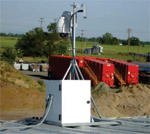
Who Goes There?
IP video cameras enhance security and safety at petroleum processing facility
- By Leslie Corriea
- Oct 01, 2010
In an age of heightened security
concerns, potentially vulnerable
manufacturing and processing
plants are re-evaluating their security
systems and looking for new ways
to protect assets. This is particularly
true of expansive facilities handling
vast amounts of volatile materials, as
monitoring large, dimly lit areas has
long been a security challenge.
When a petroleum processing facility
came to Pacific Beach Tower looking
for a video surveillance solution to
cover sensitive and hard-to-monitor
areas, officials did a walk-through security
assessment and designed a system
to tighten the facility’s security net.
Security officials solved the challenge
of monitoring many acres of
pipelines, storage tanks, equipment
sheds, railways and gantries by strategically
placing PTZ network cameras to
watch over the facility’s sensitive, hardto-
see areas 24/7. The Canon cameras
were selected because of low-light capabilities
and 40x optical zoom. By capturing
images in low-light situations,
security staff can be alerted and zoom
in on suspicious activity from inside the
security command center.
Put to the Test
Shortly after their installation, the cameras
proved their value.
One night, a suspicious car drove
into a remote corner of the facility and
parked in a newly constructed parking
lot with no lighting. Fortunately,
the recently installed cameras revealed
the presence of the vehicle and alerted
security. In virtually no light -- no
street lamps or other nearby lighting
sources -- security was able to watch the
suspects enter, observe their silhouettes
moving around and provide critical information
to help police make positive
identifications.
The cameras were set up to record
on motion detection, as this saves drive
space and makes finding important
video segments easier. The built-in, prerecord
set-up, and the cameras’ robust
software, provides the ability to capture
video of the area three, five or even 10
seconds prior to the motion event.
In addition, motion detection and
auto-tracking features enable users to
designate up to four motion-detection
areas, each with varying levels of sensitivity.
The cameras have the ability to
track a subject’s movement following a
motion event (indicated by a change in
pixels) by automatically panning and
tilting to keep the subject in the frame.
Although not used in this particular
application, pre-recorded audio also
can be set to play back on cue.
During the day, the cameras are
monitored from a remote location to
watch over all activity around the facility
and ensure that workers and contractors
comply with all regulations.
To keep images consistently looking
sharp, the cameras use a Smart Shade
Control that automatically adjusts contrast
to compensate for backlit subjects.
This proved valuable in identifying and
preventing a potential safety issue at
the facility. Recently, one of the cameras
captured someone breaking one of
the rules, and the client was overheard
calling the manager responsible for that
person to notify them of the error.
The cameras also offer a number
of other useful features in addition to
its 40x optical zoom lens, such as image
stabilization. The lens is equipped
to automatically focus on the subject
while quickly conforming to resolution.
The image stabilization feature
helps keep images steady in locations
prone to vibration, such as on towers
or poles or next to rail tracks and hightraffic
areas.
Sending Images Back to Base
The facility’s video security system is
configured to transmit images captured
by the on-site cameras wirelessly over
a HauteSpot Networks router to an
NVR. Images can be transmitted in both
high-quality VGA-size -- 640x480 --
MPEG-4 and M-JPEG formats at a
full 30 fps simultaneously without loss
of frame rate. The cameras’ powerful
hardware-based compression engine
performs all encoding, encryption and
transmission, while also enabling them
to simultaneously distribute M-JPEG
video in three sizes.
The router provides high data rates
and superior throughput for data-intensive
and latency-sensitive applications.
It can be configured to use either
the “TDMA-like” protocol, which
delivers unparalleled video streaming
performance for the most demanding
IP surveillance applications, layer-2 or
layer-3 mesh, or standard 802.11.
Powering Up
The cameras can be powered with
PoE -- via Cat-5 cable -- or DC. In this
case, independent A-plus and A-minus
lines were used so the cameras are on an
uninterruptible power system and tied
to the grid. This same power system also
can be tied directly to solar panels.
The biggest consideration when
marrying solar power with a camera
and a wireless system is the efficiency
of the products. Even when these cameras
are actively running all PTZ and
auto-focus servos at once they only
draw about 6,000 milliwatts, which
makes them very adaptable to alternative
power options.
Safe, Secure and Happy
The petroleum facility is pleased with the
high-quality results of their new networkbased
video-surveillance system and the
“live-looking” images it provides.
Clients are increasingly looking for
real live-looking video in their surveillance
solutions. The images on these
cameras look really outstanding -- even
when the NVR requires
that settings be
adjusted down.
This article originally appeared in the issue of .